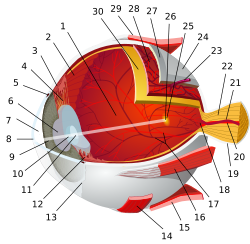|
Pharmacy Product - Types of eyes - Eyes
Eyes
Eyes are organs that detect light, and send signals along the optic nerve to the visual and other areas of the brain citation needed. Complex optical systems with resolving power have come in ten fundamentally different forms, and 96% of animal species possess a complex optical system.Image-resolving eyes are present in cnidaria, molluscs, chordates, annelids and arthropods.
 |
The simplest "eyes", such as those in unicellular organisms, do nothing but detect whether the surroundings are light or dark, which is sufficient for the entrainment of circadian rhythms. From more complex eyes, retinal photosensitive ganglion cells send signals along the retinohypothalamic tract to the suprachiasmatic nuclei to effect circadian adjustment.
The human eye is a significant human sense organ. It allows humans conscious light perception, vision, which includes color differentiation and the perception of depth. The human eye has a 200° viewing angle and can see 10 million |
Eye irritation
Eye irritation is a common problem experienced by people of all ages. There are numerous causes in which some can be prevented and treated properly. However, in order to take precaution it is important to have some basic knowledge regarding what eye irritants are and where they can be found in our environments. Eye irritation depends somewhat on destabilization of the outer-eye tear film. Certain volatile organic compounds that are both chemically reactive and airway irritants may cause eye irritation as well. Personal factors may also affect destabilization of the tear film and possibly result in more eye symptoms. Nevertheless, if airborne particles alone should destabilize the tear film and cause eye irritation, their content of surface-active compounds must be high. An integrated physiological risk model with blink frequency, destabilization, and break-up of the eye tear film as inseparable phenomena may explain eye irritation among office workers in terms of occupational, climate, and eye-related physiological risk factors.
In a study conducted by NIOSH, the frequency of reported symptoms in industrial buildings was investigated[citation needed. The study's results were that eye irritation was the most frequent symptom in industrial building spaces, at 81%. Modern office work with use of office equipment has raised concerns about possible adverse health effects.Since the 1970s, reports have linked mucosal, skin, and general symptoms to work with self-copying paper. Emission of various particulate and volatile substances has been suggested as specific causes. These symptoms have been related to Sick Building Syndrome, which involves symptoms such as irritation to the eyes, skin, and upper airways, headache and fatigue.
Many of the symptoms described in Sick Building Syndrome (SBS) and multiple chemical sensitivity (MCS) resemble the symptoms known to be elicited by airborne irritant chemicals. A repeated measurement design was employed in the study of acute symptoms of eye and respiratory tract irritation resulting from occupational exposure to sodium borate dusts. The symptom assessment of the 79 exposed and 27 unexposed subjects comprised interviews before the shift began and then at regular hourly intervals for the next six hours of the shift, four days in a row. Exposures were monitored concurrently with a personal real time aerosol monitor. Two different exposure profiles, a daily average and short term (15 minute) average, were used in the analysis. Exposure-response relations were evaluated by linking incidence rates for each symptom with categories of exposure.
Acute incidence rates for nasal, eye, and throat irritation, and coughing and breathlessness were found to be associated with increased exposure levels of both exposure indices. Steeper exposure-response slopes were seen when short term exposure concentrations were used. Results from multivariate logistic regression analysis suggest that current smokers tended to be less sensitive to the exposure to airborne sodium borate dust
|